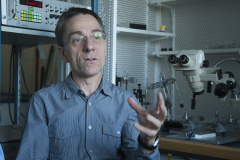Featured Lendület Member: Lilla Turiák
Membrane proteins sitting on the surface of tumour cells are often associated with sugar side chains, which have a significant impact on the function of the protein and the entire cell. In many cases, for example, these side chains determine whether or not a drug molecule enters the cell. Therefore, by examining these features, it is possible to predict how successful different therapies may be for a particular patient. Lilla Turiák, Senior Research Fellow at the Institute of Organic Chemistry of the HUN-REN Research Centre for Natural Sciences and head of the MTA-TTK Lendület (Momentum) Glycan Biomarker Research Group, and her colleagues are developing methods to study the effect of proteins with a sugar side chain on cancer with support from the Momentum Programme.
Turiák graduated as a pharmacist from Semmelweis University and started working with mass spectrometry during her PhD research at the Central Institute of Chemical Research of the Hungarian Academy of Sciences. This instrumental analytical technique is of paramount importance when components of different complex samples need to be determined qualitatively and quantitatively with high sensitivity. This is particularly important for proteins, since even small amounts of tissue, blood or urine samples can be analysed with high-throughput mass spectrometry. With the latest instruments, thousands of proteins can be determined from a sample.
 Lilla Turiák
Lilla TuriákMore detailed information on tumours
Biological conclusions about the course of various diseases can be drawn from the amount of identified proteins, but even new drug targets can be identified and previously unknown biomarkers can be discovered. “I feel fortunate to be able to use the chemical and biological knowledge that comes from my background as a pharmacist, as I work with analytical procedures, but a biological background is also essential to interpret the data,” admits the team leader.
It was during her studies at Boston University that she began to work more deeply with the analysis of sugar chains associated with proteins. Most of the membrane-embedded proteins involved in various cell-level signalling processes are glycosylated, that is contain sugar chains, and play an important role in cell-to-cell communication. For example, viruses enter cells through such cell surface receptors containing sugar chains. “As a postdoctoral researcher in the United States, I started examining very small tissue areas and developed workflows to study not only one class of molecules, but several molecular classes, such as several types of sugars, or the proteins themselves,” continues Turiák. “When I moved back home, I first worked on prostate cancer tissues because I was always interested in cancer research and how to obtain as much detailed information as possible about tumours based on a small amount of samples.”
She applied the work process she had developed to sections containing small tissue biopsies to study the altered proteins and sugar chains in them.
She was looking for changes in proteins that occur during tumour progression and how the process of glycosylation is altered.
She then switched from prostate cancer to lung cancer because patients with lung cancer have poorer survival rates. Lung cancer also has a higher incidence and mortality in Hungary. A particularly big problem is that in many cases the tumour becomes resistant to the given treatment.
Predicting the effectiveness of treatment
“In many cases, patients respond well for a while, but over time they somehow become resistant,” says the researcher. “In this regard, I first examined tissue samples from lung cancer patients who had different mutations. Over the course of the retrospective study, I was looking to find out what changes occur in the proteins and their associated sugars that might be related to whether the patient responds to the therapy. If we manage to understand all this, then it might be possible to predict this.”
Turiák submitted the Momentum application to take this further. The main goal is to predict whether a patient will respond well to a therapy in the long term by characterising the glycosylation of extracellular vesicles isolated from blood (i.e. by taking a simple blood sample). The researcher had already worked on the proteomic characterisation of extracellular vesicles during her PhD research in collaboration with Edit Buzás’ research group. These vesicles are membrane-bounded structures that detach from the cell membrane and enter the intercellular space, carrying with them various components of the original tumour cell, including some membrane proteins. This line of research has become very popular in the last 15 years, as it has been shown that these vesicles play an important role in intercellular communication. There are many proteomic, lipidomic and transcriptomic studies taking place on them, but according to Turiák, the post-translational modifications of the membrane proteins embedded in their membranes, such as the sugar chains associated with them, have been characterised by few researchers.
This is because this study is analytically challenging, partly due to the small sample size.
“The ultimate aim of the project is to isolate circulating tumour-derived vesicles from the plasma of lung tumour patients and to characterise the sugar chains associated with the proteins they contain using modern bioanalytical tools such as mass spectrometry,”
says Turiák. “Many steps in the development of the methodology will need to be optimised. A major problem is, for example, that the plasma does not only contain vesicles secreted by the tumour, as almost all cells release similar membrane spheres. So tumour-derived vesicles need to be selectively enriched so that we only examine what is associated with the disease.”
Immunoaffinity-based capture methods will be optimised for selective enrichment. As part of a prospective study, blood will be taken from newly diagnosed lung tumour patients, and this will be repeated every three months during immunotherapy. Clinical parameters indicative of patients’ responses to treatment will be monitored over time and compared with changes in protein sugar chains. They hope to find characteristics that will predict who will respond well to a given treatment and who will not.
Sugar side chains can bind different proteins and, depending on their structure, play a role in signalling pathways. For example, in the case of Covid’s pathogen, the glycosylation of the coronavirus spike protein dictates that it can bind to the angiotensin-converting enzyme receptor and thus enter the cell. “In the case of tumour cells, the big question is what exactly is the biological basis for the changes in the sugar side chains. It is certain that certain protein bonds in the tumour microenvironment are altered,” the researcher says. “When these vesicles are released, for example, during metastasis, they transmit information to the surrounding cells, thus stimulating malignant cell proliferation. But the role of these sugar side chains in drug resistance has also been described: if glycosylation on the surface changes, the cell can no longer take up the drug molecule it is trying to attack.”
















